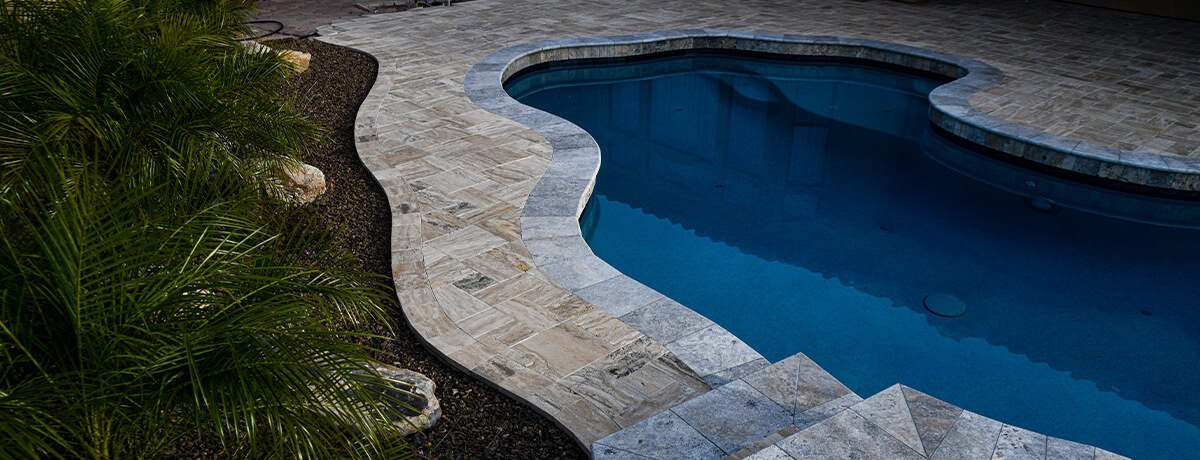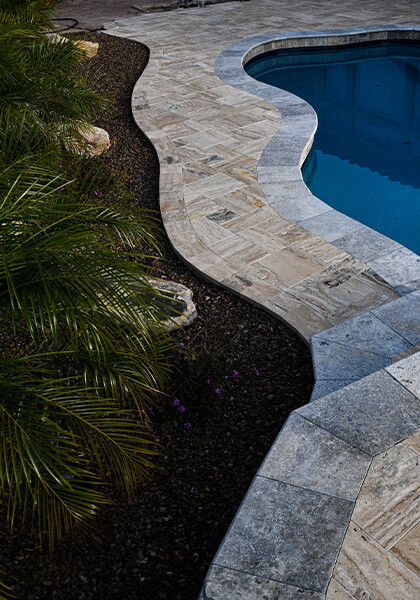Travertine Garden Paths and Stepping Stones
23rd Sep 2022

Are you looking for a new landscape design for your garden path or patio? Do you want to create a magical outdoor space in your backyard where you can relax and rest in the hot summer days underneath the garden shed or beneath the trees, surrounded by timeless beauty and nature? If so, you need a special kind of stone. And we have the answer - travertine. You can complete this beautiful picture with travertine pavers or beautiful stepping stones that will only complement nature’s breathtaking beauty right in the heart of your garden.
A travertine garden path, a patio, or fairy-tale-garden stepping stones can become the center of attention in your garden, regardless of the color or finish of the pavers.
There are many ways to utilize travertine in your garden. In this article, we will answer some of the most common questions clients have when using travertine for pavement in their gardens so that you can safely incorporate this unique natural material into your outdoor heaven.
Create a Beautiful Outdoor Space with Travertine
Travertine is the perfect stone for outdoor spaces. You can see this fabulous porous texture in many modern and contemporary buildings as wall cladding - an unmistakably noticeable decorative feature - immediately captures the attention. It is a type of limestone that is a popular building material, yet there are only a few deposits of it in the world.
This natural stone has been used for thousands of years, not only because of its ageless beauty and a unique character but because of its proven ability to withstand rough weather conditions and the test of time.
What Makes Travertine So Special?
Travertine's fibrous texture, which is reminiscent of marble and its earthy colors, makes it highly sought-after from ancient times till today. Historically, this natural stone has been used in famous architecture like the Colosseum or the modern Ghetty Center in LA and various artworks like the famous cinerary urns from "Officina di Poggio alle Croci," dating back to the 2nd century B.C.
Its name comes from the Italian word "travertino," derived from the Latin word "tiburtinus," as the Romans used it to build Rome and still today, Italian travertine dominates the market as the most prestigious and valued of travertines.
Created by millions of years of natural layering, travertine can mesmerize with its gorgeous warm colours, natural porous structure, and unique texture that make every tile or paver a unique work of art - a mountain-born beauty. Its colour palette typically includes brown, gray, rust, and beige hues. It can be left in its natural state, with no polishing, and give a natural earthy feel like no other material. Besides its dense porosity, the material could also have some traces of fossils left by the water during its formation thousands of years ago.
Why Is Travertine Good for Pavers?
Unlike bricks and concrete, travertine pavers are extremely durable, which means that they won't crack easily, and it has a 100+ years lifespan, so they will probably outlast your property. It will also increase the value of your house.

Often characterized by the pitted holes on its surface, one of the best things about this natural stone is that it isn't slippery when wet. As opposed to other man-made pavers, travertine is slip-resistant. It can be left in its natural raw cut state which is highly slip resistant without hurting the barefoot or if you are looking for a slightly more refined look, there are various surface finishes which can be applied to travertine pavers and stepping stones, like brushed, sandblasted or antique (a mixture of bush hammered and brushed) which make the stone look amazing and maintains the high level of safety needed when wet. Pavers, garden paths, or stepping stones made of this natural material can withstand extreme cold and hot, making them ideal for any climate.
Nothing can be worse than stepping barefoot on extremely hot pavement or a patio on a summer day. Travertine, however, does not heat up like concrete or brick pavements, making it the preferable choice of material for a pool deck, a garden path, and other outdoor solutions in your backyard.
How to Clean Travertine?
Travertine pavers' care and maintenance seem to be one of the main concerns for homeowners who want to incorporate this gorgeous stone into their outdoor area. If you think your pavement needs additional cleaning, you can use warm water with a sponge or a mop. Make sure that the fabric is not abrasive. Use only gentle neutral cleaning agents, free of any acid. We recommend thorough cleaning for outdoor travertine to be done once every couple of years with a power hose. It would remove soil and dirt and bring out the stone’s beautiful natural colours. On the other hand, some people prefer to leave the stone to weather, especially when used as stepping stones, as the stone takes on a natural beauty as it ages.
Travertine pavers are durable and can withstand rain and snow. However, when installed outside, nature could impact travertine negatively (like any other material). Not all travertine is the same and low quality travertine can scratch. If you want to avoid this make sure to buy high quality travertine which comes from deposits like at Saturnia.
Do travertine pavers and stepping stones crack?
Travertine pavers and stepping stones are usually thicker than tiles and slabs to avoid cracking in an outdoor context where there isn’t a solid base support. They are usually between 3cm and 8cm (the thicker ones usually used where there is heavy traffic like a driveway). With these thicker formats, the risk of cracking is reduced to a minimum and only happens if the stone is not installed well and there are voids or sinking ground under the pavers. The only way to know what caused the crack is to remove the affected paver and see what is the cause underneath it.
On those rare occasions that a paver cracks, it is usually a hairline crack. Some people decide to leave the paver as is (making sure it is firmly supported on all sides so it does not separate) as it is not evident or if you prefer, you can use a filler made for filling cracks or fissures for stones. Make sure to use the same color, matching the color and the finish of the paver. Often, the best solution is to be prepared and when making your order, add 5-10% more as replacements, should you need it decades down the line.
In Conclusion…
As one of the oldest building materials in existence, travertine has proven its ability to withstand weather conditions and the test of time. Besides its beauty and unique character, this durable natural material shows that it can be the perfect choice for any garden or outdoor area. Travertine’s lifespan outdoors is thought to be 100+ years, meaning that you will enjoy your pavement or stepping stones in the garden for decades to come.

